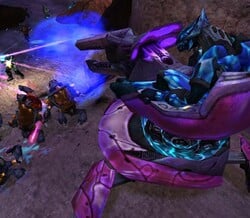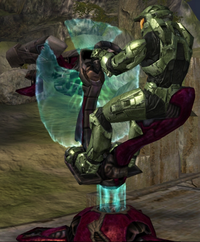Shade
From Halopedia, the Halo wiki
The Shade is the Covenant's standard stationary gun turret and anti-infantry weapons platform.
Overview
The Shade is a Covenant stationary gun turret and anti-infantry weapons platform, manned in third person like a vehicle. It consists of a sturdy base and a floating, mobile, turret-like seat with control systems for its "nozzle". It first appeared in Halo: Combat Evolved. In Halo 2, the Shade was mostly protected with energy shields at the front of it, similar to a Jackal's. A similar gun to the Shade can be found as a defensive weapon on Spirit and Phantom dropships. In Halo 3, the Shade's shield is replaced with real physical armor, the base is now firmer, and the Shade has a much bulkier reinforced forefront to protect the gunner.
The first known encounter with Shades was in 2535 during the Battle of Jericho VII.
Operation
The Shade gun fires two (three in Halo: Combat Evolved) slow moving, high powered bolts of plasma encased in magnetic fields. The accuracy of a Shade's weapon is fairly low, as the bolts of plasma fired can hit anywhere within the aiming reticule. Since it is designed with infantry combat in mind it is highly effective against Grunts and Jackals, and has exhibited limited effectiveness against Elites (especially at dropping their shields). But due to their intelligence Elites can often find cover and escape the Shade's field of fire. Its shots lack the required punch to damage Hunters, whose armor and combat shield are immune to it. It is also fairly ineffective against the Flood, like most other plasma based weaponry.
The Shade offers a wide field of fire and a 360 degree traversable mount. It is highly effective at combating light infantry, has shown a good ability against light vehicles such as the Ghost and in desperate situations can serve as anti-aircraft defense (a few direct hits is all it needs to destroy a Banshee).
Models
There are 3 models encountered so far in the Halo universe
Shade (Halo: Combat Evolved)
The shade first appeared in Halo: CE, and was mostly feared because of its devastating anti-infantry bolts. But however, there were many weaknesses:
- It is possible to snipe a Shade gunner off its turret, but one must aim above the center (which the red reticule usually denotes) and at the user itself, since the Shade protects the user.
- It is also possible to melee attack a foe off of a Shade.
- The gunner is highly exposed atop the Shade, with cover only available via the gun mechanism itself. This leaves the operator open to flanking maneuvers and attacks from multiple angles. This poses a serious disadvantage to the gunner.
- The turret is not permanently fixed to the ground, supposedly for movement/deployment purposes. As such, explosives are an ideal way of uprooting the Shade and ensuring it is subsequently out of action. If the Shade is turned over, then it is possible to flip it back upright.
- Some players have been known to melee and grenade these weapons along with them to give them a powerful weapon/shield becuase the shade is indestructible.
- Also used as a turret for the Spirit dropship.
Shade (Halo 2)
The Shade returned in Halo 2, where it is referred to as the Shielded Plasma Turret. It fires slow moving, red plasma bolts that do a large amount of damage. To protect the gunner, this turret is equipped with an energy shield, similar to the Jackal Personal Arm Shield. If you want a more detailed look, start the campaign level Delta Halo or while playing the campaign level Great Journey when you are in the Banshee shooting enemies and turrets down, as well as when inside the control room when there are Brutes manning them. This is the best protected turret.
Shade Turret on Shadows
In Halo 2, the turret on the Shadow is very similar in appearance to the Shade in Halo: Combat Evolved. The plasma bolts it fires are more similar to those fired by the Halo 2 Shade. It should be noted, that these turrets seem more powerful than the standard shade in Halo 2, and also offers more protection.
Shade (Halo 3)
Type-26 ASG
In Halo 3, the Shade now has a model name, which is Type-26 ASG. It is often operated by the Grunt race, specifically the green-armored Grunt Heavys. The Shade, once again, is elevated on a small gravity lift, and so has a full 360 degree field of view. The Shade is seen in the Halo 3 campaign missions The Ark, Tsavo Highway, and The Covenant . The Shade was in multiplayer only in Halo 3 Epsilon. As it was removed from the final version, even in Forge. This is most likely because of its weak durability, allowing very few player to be able to use it and you can only place movable objects in Forge. [1]
Advantages
As with its human counterpart, the AIE-486H HMG, the Shade is very effective against both enemy ground forces and light vehicles. Some of its advantages over the HMG are that the plasma bolts are accurate and effective at longer distances and it is easier to see where your shots are actually going than it is with the HMG’s tracer rounds. In a multi-player game a well-placed observer can help you place hits from the other side of some of the largest maps such as Coagulation. The Shade is also capable of rotating 360 degrees so that you can fire on enemies trying to sneak up behind you. It is also strong enough to withstand a direct hit from a Wraith’s mortar (only if the gunner on it has strong shields or health).
Below, you can see the number of hits you need to make a kill with the Shade. Targets used were on foot and the location on the body where they were hit showed no apparent barring on how many hits it took to kill them. (A normally shielded target took the same number of hits to kill when shot in the legs as when shot in the head) In the case of the Overshield, the target had one at full charge.
(Note: This test was performed with the Shade in Halo 2, but damage caused by the 3 models of Shade are roughly the same, so this can also be an estimation of the damage the other models cause)
- Unshielded Target: 2 shots for a kill
- Normal Shielding Target: 6 shots for a kill
- Overshielded Target: 13-14 shots for a kill
Disadvantages
As with the HMG, when you are using the Shade you are extremely exposed to enemy fire and become a target that any good commander will want to eliminate immediately. A single hit by a rocket or well placed plasma grenade will destroy the turret, as will a direct hit from a M68 Gauss Cannon or the main cannon of a Scorpion Tank. In addition, while it is capable of withstanding a direct hit from a Wraith, it will still completely deplete your shields. While it is useful against enemies in light vehicles, this is not a weapon to use when faced with an enemy tank; you will be dead long before the tank is. You are also vulnerable to snipers and scoped weapons. Also, as is the case with the HMG, you are unprotected from the rear, although this is lessened by the ability to completely rotate the turret. It is advisable to have a teammate nearby to help cover you when you are using a turret. Also in Halo 3 the Shade has an extremely slow rate of turn, which means it is best to have a friendly covering you.
Recommended Tactics
When using a turret
- Buddy Up. While this is good advice in general, here it is very true as your rear is completely unprotected. Having a teammate nearby to cover your blind side greatly improves your effectiveness.
- Know when to bail out. If you see an enemy tank turning its gun towards you it is typically a good idea to find some better cover until it moves on.
- Hiding behind the turret is a very good strategy, since the turret has shields.
When facing a turret
- Find an explosive to throw at them. A tank, rocket, or Gauss round will do the trick. If you are close by and on foot, try sticking them with a plasma grenade.
- Find a scoped weapon. A Battle Rifle, Carbine, Sniper Rifle, or Beam Rifle will let you take them out with head shots from farther out then they can see you. Of course, if they have a teammate guiding their fire then it would be advisable to eliminate the spotter first and then the gunner.
- For the Shade in Halo Combat Evolved, you can simply walk right in front of the turret at point blank range, the gunner AI will usually just stare at you until you move back into range. However, when manned by a player online, this tactic is useless as they can fire at point blank range.
- Keep circling the turret until you find a part where the gunner's body is more exposed then open fire.
- A fully charged plasma bolt can prevent the turret from turning. Take advantage of that.
Design
When the Shade was introduced in Halo: CE, it took the shape of a bowl with a gun at its front. This version of the shade was the most vulnerable to enemy fire to the front, as the front wasn't reinforced well. This version of the Shade fires 3 purple plasma shots.
In Halo 2, it looked weak, with the bowl shape stripped, and replaced with a shield, very similar to a Jackals', at the front. This way, it's more protected at the front, but much weaker at the sides and back. An enemy could just sneak up at the back and melee the gunner dead, which is one of its weak points.
The Shade returned in Halo 3. In contrast to the Shade from Halo 2, the Halo 3 version seems much better defended, with physical armor encompassing the turret's user. While the cannon hovers on a small gravity lift like the Shade from the previous two games, the base is entrenched, and so the device isn't mobile. However, much like the Shade in Halo: Combat Evolved it is highly vulnerable to grenade or explosive strikes due to its stationary nature.
Comparison
Here is a table comparison of the different shade versions in the Halo trilogy:
Similarities
- All 3 are used against vehicles and personnel.
- All 3 are turrets designed by the Covenant.
- All 3 turrets float on an anti-gravity "cushion" projected by their bases.
- All 3 fire almost equally damaging plasma bolts, though they are different in appearance
- All 3 turrets are extremely vulnerable to explosives
Differences
| Halo: Combat Evolved | Halo 2 | Halo 3 |
| Protected at all sides with a bowl-like shape | Protected at the front with an energy shield | Superbly reinforced on the front. Sides slightly protected |
| Mobile, can be knocked off its base with a melee | Stationary | Stationary, Although the ball can be knocked off. |
| Rate of fire (High) | Rate of fire (Low-Medium) | Rate of fire (High) |
| Turning speed (Fast) | Turning speed (Medium) | Turning speed (slow) |
Character Compatibility
- Elites
- Brutes (Halo 2 and 3 only)
- Spartans
- Grunts
- Marines (Have animation, but not used in-game).
- Flood Human Combat Form (Halo 2 only)

